News
Cloud Report: Microsoft Azure Usage Surpasses AWS
Microsoft's Azure continues to gain popularity on Amazon's cloud, according to the Flexera 2022 State of the Cloud Report, the 11th annual survey-based project from the specialist in SaaS-based IT management solutions.
Based on the survey that garnered 753 respondents late last year, the cloud firm found that Azure usage has actually surpassed that of Amazon Web Services.
"Data from this year's survey indicates Azure seems to be either closing the gap -- or has slightly surpassed -- AWS with some users," the report says. "As the first large-scale cloud provider, AWS is used more frequently by organizations that have been using the cloud over a longer period and are heavy cloud users. Across all respondents, 81 percent of heavy cloud use organizations use AWS compared with 80 percent using Azure. Among organizations with moderate cloud use Azure has a slight lead and enjoys higher adoption for organizations that are light users. Although Google Cloud Platform remains in third place among all maturity levels, its popularity is significantly higher (51 percent) within organizations with heavy use of the cloud."
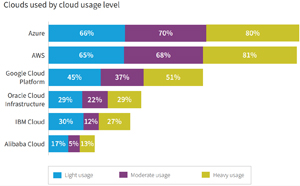 [Click on image for larger view.] "Azure surpassed AWS among light and moderate users and is closing the gap with heavy users." (source: Flexera).
[Click on image for larger view.] "Azure surpassed AWS among light and moderate users and is closing the gap with heavy users." (source: Flexera).
Here's a graphic from the 2022 report about enterprise public cloud adoption rates:
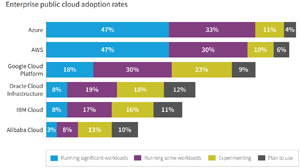 [Click on image for larger view.] "Azure surpassed AWS for enterprises running some or significant workloads on the platforms." (source: Flexera).
[Click on image for larger view.] "Azure surpassed AWS for enterprises running some or significant workloads on the platforms." (source: Flexera).
Here's a similar graphic from last year's report:
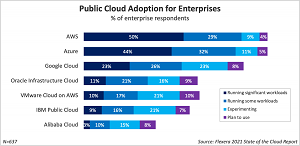 [Click on image for larger view.] Public Cloud Adoption (2021 report) (source: Flexera).
[Click on image for larger view.] Public Cloud Adoption (2021 report) (source: Flexera).
While the above constitutes one of four main takeaways from the report as presented by Flexera, the other three are:
-
The need for FinOps grows: Cloud costs continue to grow, and the amount of waste remains high. Numerous roles, including IT/Ops, cloud centers of excellence and FinOps teams, are seeking to keep costs down.
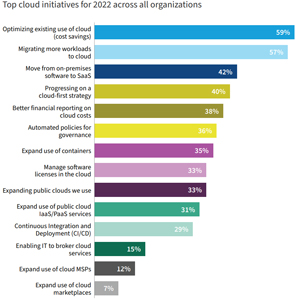 [Click on image for larger view.] "Cost-control measures and moving to SaaS solutions are top of mind." (source: Flexera).
[Click on image for larger view.] "Cost-control measures and moving to SaaS solutions are top of mind." (source: Flexera).
-
Native tooling gains traction: Third-party tools that assist in areas such as orchestration and container management seem to be losing ground to native tooling from the cloud providers themselves.
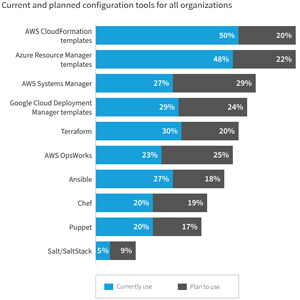 [Click on image for larger view.] "Provider-specific tools are hard for organizations to resist." (source: Flexera).
[Click on image for larger view.] "Provider-specific tools are hard for organizations to resist." (source: Flexera).
-
Growth of SMB cloud usage: Cloud spend by SMBs reflects a massive uptake, with 53 percent of SMBs spending more than $1.2 million -- up from 38 percent reported last year.
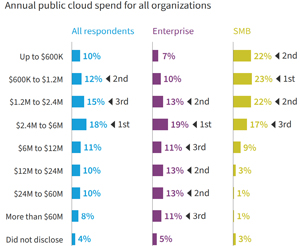 [Click on image for larger view.] "Public cloud spend is now a significant line item in all IT budgets." (source: Flexera).
[Click on image for larger view.] "Public cloud spend is now a significant line item in all IT budgets." (source: Flexera).
Other highlights of the comprehensive report as presented by Flexera include:
- Enterprises embrace multi-cloud:
- 89 percent of enterprises have a multi-cloud strategy, 80 percent have a hybrid cloud strategy
- Many organizations silo applications within a given public or private cloud, with 45 percent siloing apps on different clouds, 44 percent using DR/Failover between clouds, and 41 percent integrating data between clouds
- 41 percent of participating organizations with more than 10,000 employees use multi-cloud security tools and 37 percent of all participating organizations use multi-cloud cost management tools
-
Public cloud adoption continues to accelerate:
- 37 percent of enterprises spend more than $12 million per year on public clouds
- More than 55 percent of all respondent workloads and data are expected to be in a public cloud within 12 months
- Sixty-six percent of respondents said cloud usage is higher than initially planned this year, though 90 percent had predicted higher usage last year due to Covid
- 53 percent of all respondents said the top challenge in cloud migration is understanding application dependencies
-
Understanding cloud initiatives and metrics:
- 59 percent of organizations plan to optimize existing use of cloud (cost savings), making it the top initiative for the sixth year in a row
- 57 percent of organizations plan to focus on cloud migration
- 74 percent of organizations use cost efficiency and savings to measure cloud progress
-
Organizations taking a centralized approach to cloud:
- 74 percent of enterprises have a central cloud team or cloud center of excellence (CCoE)
- 53 percent of cloud teams are responsible for governing infrastructure-as-a-service (IaaS)/ platform-as-a-service (PaaS) usage and costs
- 57 percent of enterprises reported using cloud managed service providers (MSPs) to manage public cloud use
-
Top challenges are security, spend, governance and expertise:
- 85 percent of all respondents indicate that security is a challenge, followed by 83 percent for lack of resources/expertise, and 81 percent for managing cloud spend
- For light cloud users, lack of resources/expertise is the top challenge (84 percent); for heavy cloud users, security is the top challenge (84 percent). Managing cloud spend is a challenge for all respondents (81 percent)
- 37 percent of organizations reported that understanding cost implications of software licenses is a challenge of software in the cloud
-
Organizations struggle to handle growing cloud spend:
- Organizations are over budget for cloud spend by an average of 13 percent and expect cloud spend to increase by 29 percent next year
- Respondents estimate organizations waste 32 percent of cloud spend
- Organizations aren't taking advantage of all cloud provider discounting options, but are beginning to leverage automated policies to shut down workloads after hours (45 percent) and rightsize instances (42 percent)
-
Containers are now mainstream:
- 47 percent of organizations are currently using AWS ECS/EKS for containers, 43 percent use Docker, and 42 percent use Kubernetes
- Container-as-a-service (CaaS) offerings from the public cloud providers continue to gain traction with customers; this year, a CaaS tool (AWS ECS/EKS) surpassed Docker for the top spot
- Lack of internal staff with expertise is cited by 42 percent of respondents as a top container challenge
-
Adoption of cloud configuration tools is shifting:
- AWS CloudFormation templates (50 percent) and Azure Resource Manager templates (48 percent) are now the configuration tools most widely adopted by respondents
- Third-party tool usage declined from last year: Terraform dropped from 36 percent to 30 percent; Chef dropped from 27 percent to 20 percent; Puppet dropped from 27 percent to 20 percent; Ansible dropped from 31 percent to 27 percent; and Salt/SaltStack dropped from 12 percent to five percent
- The highest percentage of enterprise respondents use Azure Resource Manager templates (52 percent) while the highest percentage of SMBs used AWS CloudFormation templates (47 percent)
-
Use of public cloud PaaS services is rising:
- At 58 percent, data warehouse has the highest adoption among enterprises
- Serverless (Function-as-a-Service) and Machine learning/Artificial Intelligence (AI) have the highest percentages of enterprise respondents experimenting, 29 percent each
-
Private cloud adoption:
- Microsoft Azure Stack increased slightly YoY to 37 percent and replaced VMware vSphere, now at 31 percent, for the top spot for all users
"One thing is for certain," Flexera said in summary. "To remain competitive and maximize the available advantages, organizations must make strategic decisions about cloud architecture, usage of public clouds, effective tooling and cloud cost management. And the siloed and disjointed approaches of yesterday will no longer be effective in today's fast-evolving digital world."
About the Author
David Ramel is an editor and writer at Converge 360.